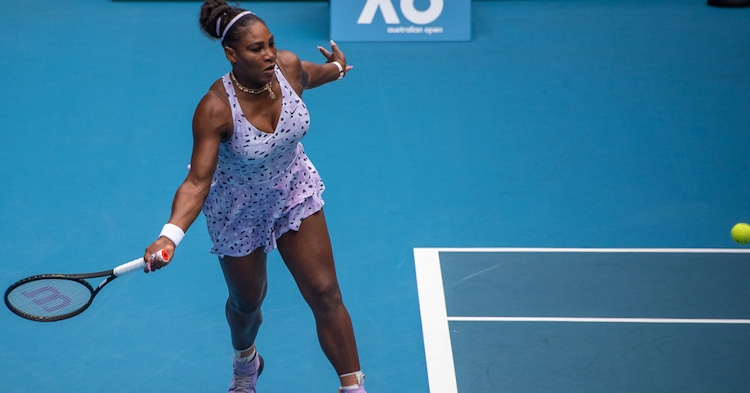Serena Williams The Problem Solver: Improbably Underrated
Last updated: May 12, 2021, 2:17AM | Published: Feb 14, 2021, 9:49PM
This image is a derivative of Australian Open 2020 by Rob Keating (CC BY 2.0)
Some people will very reasonably and logically ask: “How can a 23-time major champion have a significantly underrated component of her game? How is that even possible?”
Those questions come from a very honest place. Does Serena Williams own significantly underrated components of her game? Surely with a player who has inspired so many columns of praise and so many on-camera words of admiration over two decades of tennis brilliance, everything has been said…
…right?
It’s complicated.
Yes, everything has been said about Serena Williams, but has everything been said in full measure, and to the same degree? This is where – and why – I arrive at the conclusion that some dimensions of this tennis icon are still underrated.
Do tennis analysts and commentators give Serena Williams credit as a problem solver and tennis thinker, not just as a server, ball-striker, determined competitor, and supreme crunch-time performer? Yes, they do…....but they haven’t done so in equal measure.
RELATED: Who's the current favourite to win the 2021 Australian Open?
If you were to lose yourself in a Serena Williams media rabbit hole – and go through press clippings and column archives from the past 20 years – see how often Serena’s game is described in specific ways.
Consider the word “tough” or other adjectives close to it.
Consider the word “fierce” or other adjectives in the same ballpark.
Look for the word “determined” and other words which speak to the hunger with which Serena competes.
In the last several years of her career, notice how often match reports examine her footwork and movement as keys to her success.
Let’s be clear: All those adjectives, and all that time spent on her footwork and movement, were, and are, appropriate. It’s not as though every hymn of praise you have ever heard about Serena is somehow false.
Nope – it’s all true, and I’m not debating whether any of these plaudits are true.
The point is that her problem-solving abilities simply aren’t given as much ink or air time.
This is the part of her game which, by comparison to all her other shining attributes, doesn’t receive the same level of attention, and therefore doesn’t sink into the public consciousness.
Yes, of course it’s true that Serena doesn’t give up, doesn’t let go, doesn’t enable opponents to avoid answering tough questions.
Yes, of course it’s true that Serena has the best serve in the history of women’s tennis and can knock the stuffing out of a ball. We’re not debating how great Serena is in those areas.
It’s just that you don’t hear or read the same copious quantities of articles on how clever and deft Serena is. You don’t get as many columns on how calm and patient Serena is. Her roars and her intensity often mask her problem-solving capacities.
When I speak of Serena’s calm, it’s not an outer calm, precisely because of the vocal and emotionally invested way she often plays. It’s an inner calm manifested in her ability to accept bad patches of play – they happen for her in her advanced tennis age – and move past them.
RELATED: At The 2021 Australian Open, Everyone Is Waiting For The Next WTA Breakout
So many less accomplished tennis players – and beyond tennis players, athletes in general – get stuck by thinking about the opportunities they squandered minutes earlier. The very best athletes, the elites in any sport, are masters of turning the page and staying connected to the present moment. Yes, they’re upset they let chances slip away, but they use that anger to focus their concentration rather than undermine it. They get pissed off and then do something about it, rather than getting angry in a way which distracts them and causes them to unravel in a cloudy sea of confusion and disorder.
That is what Serena Williams – underneath the outward roars and suggestions of emotional turmoil – regularly does. It’s what she did against Aryna Sabalenka in the fourth round of the Australian Open. 
RELATED: Be sure to follow all of Stats Insider's Live Pre and In-Game Projections
It’s not really emotional turmoil. It’s more a matter of giving expression to one’s emotions on the surface while, underneath, being realistic about the challenges involved in match play and the limitations of one’s tennis at age 39.
There is a delicate balance involved in managing one’s body and emotions. There are times when restraint is necessary, and there are times when venting is necessary. Serena knows what to do and when to do it better than her opponents – she has been proving as much for more than 20 years.
She proved it again versus Sabalenka.
Yes, Serena was crushed in the second set. Yes, she watched a 4-1 lead turn into a 4-4 battle for survival in the third… but she rode it out. She usually does. That’s match management. That’s a mature handling of a complicated, layered situation.
The players on tour – there are dozens if not hundreds of them – who fail to reach their potential are the ones who get into these tight spots and don’t manage their emotions in a constructive way.
It’s not just about getting nervous. It’s about going for too much on certain shots in certain situations, or being overly cautious and unwilling to pull the trigger. Failing to manage a match sometimes means being locked into patterns instead of using a Plan C to either throw off an opponent, or provide personal space for one’s own needed adjustments.
Serena, for all her power and ruthless hitting, uses a measure of touch – or angle, or tactical alteration – to give her opponent something to think about. She displayed this against Sabalenka, and it steered her through that rocky third set. The plan and its effectiveness might not be apparent in the immediate moment, but over the course of a full set, the purpose of the nuances and tactical shifts comes into clearer focus.
Given how flustered Sabalenka was in the final game of the match, leading to an unusual and sarcastic reaction to the match point she lost, we can reasonably conclude that Serena won this match with her mind as much as her body.
Yes, all the things you read about Serena’s toughness, ferocity, and determination are true. Again, we’re not saying or implying they’re false.
It’s just that the deeper inner workings of a tennis mind – managing a match, making tactical adjustments, weathering the storm, patiently accepting realities and gradually responding to them – are not written about on the same scope or scale when Serena Williams is the object of focus.
To that extent – and within that context – she owns an underrated component of her game. Yes, it's possible to underrate an aspect of a 23-time major champion’s portfolio.
More attention needs to be given to that reality.
Did you enjoy this article? Join our free mailing list to get the best content delivered straight to your inbox, or join the conversation by leaving a comment below or on the Stats Insider Twitter or Facebook page.



